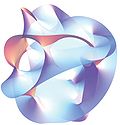User:Polytope24
| Me | |||||||||||||||||
| Talk | Contributions | Awards | Sandbox | ||||||||||||||
Hello, I'm Polytope24. I've been contributing to Wikipedia since July, 2013. I'm mainly interested in improving Wikipedia's coverage of string theory and related topics in quantum field theory and mathematical physics. I enjoy the challenge of explaining these technical subjects in an accessible way while still making the articles comprehensive and useful to experts. So far, I've helped bring three of the string theory articles to featured status.
Featured articles
[edit]November 17, 2013
[edit]The anti-de Sitter/conformal field theory correspondence is a conjecture in theoretical physics that relates two kinds of physical theories. On one side of the correspondence are conformal field theories, including theories similar to the Yang–Mills theories that describe elementary particles. On the other side of the correspondence are anti-de Sitter spaces (cross section depicted), which are used in theories of quantum gravity, formulated in terms of string theory or M-theory. Proposed by Juan Maldacena in late 1997, the AdS/CFT correspondence represents a major advance in our understanding of string theory and quantum gravity. This is because it provides a non-perturbative formulation of string theory and because it is the most successful realization of the holographic principle, an idea in quantum gravity originally proposed by Gerard 't Hooft. In addition, it provides a powerful toolkit for studying strongly coupled quantum field theories and has been used to study many aspects of nuclear and condensed matter physics by translating problems in those subjects into more mathematically tractable problems in string theory. (Full article...)
April 13, 2014
[edit]In mathematics and theoretical physics, mirror symmetry is a relationship between geometric objects called Calabi–Yau manifolds (pictured). The term refers to a situation where two Calabi–Yau manifolds look very different geometrically but are nevertheless equivalent when employed as extra dimensions of string theory. Mirror symmetry was originally discovered by physicists. Mathematicians became interested in this relationship around 1990 when Philip Candelas, Xenia de la Ossa, Paul Green, and Linda Parks showed that it could be used as a tool in a branch of mathematics called enumerative geometry. Today mirror symmetry is a major research topic in pure mathematics, and mathematicians are working to develop a mathematical understanding of the relationship based on physicists' intuition. Mirror symmetry is also a fundamental tool for doing calculations in string theory, and it has been used to understand aspects of quantum field theory, the formalism that physicists use to describe elementary particles. Major approaches to mirror symmetry include the homological mirror symmetry program of Maxim Kontsevich and the SYZ conjecture of Andrew Strominger, Shing-Tung Yau, and Eric Zaslow. (Full article...)
March 25, 2015
[edit]In physics, M-theory is a unification of what were originally thought to be five distinct versions of superstring theory. The possibility of such a theory was first conjectured by Edward Witten (pictured) at a string theory conference at the University of Southern California in 1995, initiating a flurry of research activity known as the second superstring revolution. Work by several physicists showed that the original five theories could be related by transformations called S-duality and T-duality. Witten's conjecture drew on these dualities and on a field theory called eleven-dimensional supergravity. Some physicists believe that a complete formulation of M-theory could provide a framework for developing a unified theory of all the fundamental forces of nature. Current directions of research in the theory include matrix theory and gauge/gravity duality. According to Witten, the M in M-theory can stand for "magic", "mystery", or "membrane" according to taste, and the true meaning of the title should be decided when a more fundamental formulation of the theory is known. (Full article...)
Other articles
[edit]Other projects include:
Articles I have created (but don't intend to work on too much) include:
Userboxes
[edit]
|
|




